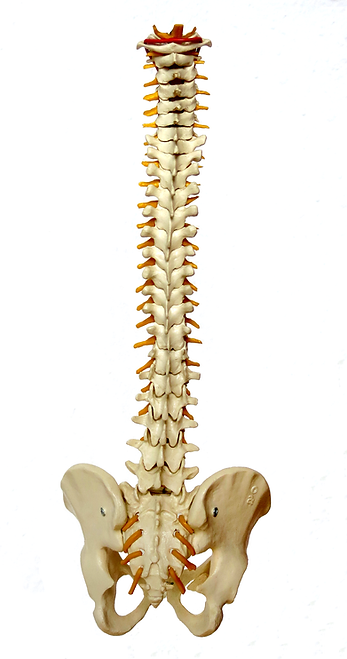Chiropractic is a healthcare profession that focuses on disorders of the musculoskeletal and nervous systems, and the effects of these disorders on general health. Chiropractic services are used most often to treat neuromusculoskeletal complaints, such as headaches, back pain, neck pain, and pain in the joints of the arms or legs. Doctors of Chiropractic (DCs) – often referred to as chiropractors or chiropractic physicians – practice a hands-on, drug-free approach to healthcare that includes patient examination, diagnosis and treatment. Chiropractors have broad diagnostic skills and are also trained to recommend therapeutic and rehabilitative exercises, and to provide nutritional, dietary and lifestyle counseling.
DCs may assess patients through clinical examination, laboratory testing, diagnostic imaging and other diagnostic interventions to determine when chiropractic treatment is appropriate. Chiropractors will readily refer patients to the appropriate healthcare provider when chiropractic care is not suitable for the patient’s condition, or the condition warrants co-management in conjunction with other healthcare providers.
In many cases, such as lower back pain, chiropractic care may be a patient's primary method of treatment. When other medical conditions exist, chiropractic services may complement or support medical treatment by relieving the musculoskeletal aspects associated with the condition.

bonesetters
Spinal manipulation is one of the oldest and most widely practiced healing methods; manual and manipulative procedures have been depicted in the art and writings of most ancient cultures. References to spinal manipulation, and even the term subluxation, can be traced as far back as Hippocrates and Galen. Although manipulation has been part of traditional medicine practice for centuries, most nonmedical practitioners of spinal manipulation in the 19th century were “bonesetters” who had learned their skills primarily through apprenticeship and observation.
The term “chiropractic” combines the Greek words cheir (hand) and praxis (practice) to describe a treatment done by hand. Hands-on therapy -especially adjustment of the spine - is central to chiropractic care. Chiropractic is based on the relationship between the body’s structure (primarily that of the spine) and its function (as coordinated by the nervous system) and how it affects health.
Modern-day chiropractic dates back to September 18, 1895, when Daniel David Palmer manipulated the spine of Harvey Lilliard, allegedly restoring Mr. Lilliard's sense of hearing.
Although chiropractic originated in the United States (the primary training ground and theoretical inspirational source for chiropractors), it took less than 10 years for chiropractors to immigrate and begin practice in other countries. In 1923, the province of Alberta in Canada became the first jurisdiction to license chiropractic outside the United States; in 1939, the canton of Zürich in Switzerland became the first to license the profession outside of North America. Today, chiropractors are licensed and regulated in many countries throughout the world (18) and are permitted to practice in most countries, pursuant to general law.
Payments for chiropractic care historically came directly from patients’ pockets until chiropractic services were included in Medicare in the 1970s. In the past few decades, chiropractic has been included in a substantial proportion of private and public insurance plans, all state workers-compensation systems, and all forms of managed care (including health maintenance organizations)
In the past few decades, chiropractic has strengthened its educational system; initiated research that has validated spinal manipulation; increased its market share of satisfied patients; initiated collaborations with other disciplines in practice, research, and professional settings; and effectively used political, legislative, and legal measures to secure a role. But a continued attitudinal bias from mainstream allopathic medicine still hinders chiropractic.
Nevertheless, today in the U.S., despite decades of persecution by government and organized medicine, chiropractors have become the third largest group of health professionals who have primary contact with patients (after physicians and dentists).
History of the
THEORY
Chiropractic theory has held that subluxation and manipulation can have important physiologic effects: increased range of joint motion, changes in facet joint kinematics, increased pain tolerance, increased muscle strength, attenuation of beta-motoneuron activity, enhanced proprioceptive behavior, and changes in endorphins and substance P.
A biomechanical picture of manipulation is beginning to emerge from studies on the forces involved and the resultant kinetics and kinematics.

Two broad categories of chiropractic research have been pursued:
1) clinical outcomes in randomized clinical trials and observational studies and
2) basic science efforts attempting to understand the biological mechanisms of spinal manipulation.
Most trials have been published in general medical and orthopedic journals (for example, British Medical Journal, Journal of the American Medical Association, Spine). Several studies have been published in the chiropractic peer-reviewed literature (for example, Journal of Manipulative and Physiological Therapeutics).
Most of these studies have been conducted on patients with low-back, neck, and head pain, and a few have examined other conditions. The clinical trials include placebo-controlled comparisons, comparisons with other treatments, and pragmatic comparisons of chiropractic management with common medical management. Researchers have studied spinal manipulation for many conditions ranging from back, neck, and shoulder pain to asthma, carpal tunnel syndrome, fibromyalgia, and headaches. Much of the research has focused on low-back pain, and has shown that spinal manipulation benefits some people with this condition.
43 randomized trials of spinal manipulation for treatment of acute, subacute, and chronic low back pain have been published. 30 favored manipulation over the comparison treatments in at least a subgroup of patients, and the other 13 found no significant differences. No trial to date has found manipulation to be statistically or clinically less effective than the comparison treatment. 11 of the low-back pain trials included a placebo group; 8 of them showed an advantage to manipulation.
11 randomized, controlled trials of spinal manipulation for neck pain have been conducted; 4 had positive findings and 7 were equivocal. Seven of 9 randomized trials of manipulation for various forms of headache were positive.
In most of the randomized, controlled trials of manipulation for musculoskeletal pain, the positive effect sizes appear to be clinically and statistically significant, but not dramatic, leaving room for various interpretations. Systematic reviews and meta-analyses conducted in the early to mid-1990s made cautiously positive or equivocal statements about the effectiveness of manipulation for low-back pain, neck pain, and headache, and called for higher-quality studies.
In 1994, the U.S. Agency for Health Care Policy and Research concluded that spinal manipulation was safe and effective for acute low-back pain, with a strength of evidence level of “B.” This agency reviewed all clinical trials available at the time and found no other treatment to have stronger evidence, although nonsteroidal anti-inflammatory drugs received the same “B” rating.
A more recent 2010 systematic review concluded that spinal manipulation/mobilization is effective in adults for: acute, subacute, and chronic low back pain; migraine and cervicogenic headache; cervicogenic dizziness; manipulation/mobilization is effective for several extremity joint conditions; and thoracic manipulation/mobilization is effective for acute/subacute neck pain.
One of the most common and well known therapeutic procedures performed by doctors of chiropractic is spinal manipulation (sometimes referred to as a "chiropractic adjustment"). The purpose of spinal manipulation is to restore joint mobility by manually applying a controlled force into joints that have become hypomobile – or restricted in their movement – because of a tissue injury.
Tissue injury can be caused by a single traumatic event, such as improper lifting of a heavy object, or through repetitive stresses, such as sitting in an awkward position with poor spinal posture for an extended period. In either case, injured tissues undergo physical and chemical changes that can cause inflammation, pain, and diminished function. Manipulation, or adjustment of the affected joint and tissues, restores mobility, thereby alleviating pain and muscle tightness, allowing tissues to heal.
Chiropractors may combine the use of spinal adjustments and other manual therapies with several other treatments and approaches such as:
-
Heat and ice
-
Electrical stimulation
-
Relaxation techniques
-
Rehabilitative and general exercise
-
Counseling about diet, weight loss, and other lifestyle factors
-
Dietary supplements
Techniques
Research







Chiropractic is well established in the United States, Canada, the United Kingdom, and Australia. Like their MD colleagues, doctors of chiropractic are subject to the boundaries established in state practice acts and are regulated by state licensing boards.
A recent study described U.S. chiropractic curricula as an average of 4820 classroom and clinical hours, with about 30% spent in the basic sciences and 70% in clinical sciences and internship. Medical school curricula average about 4670 hours with a similar breakdown. Compared with medical students, chiropractic students spend more hours in anatomy and physiology but fewer in public health.
Further, their education in 4-year doctoral graduate school programs is nationally accredited through an agency that operates under the auspices of the U.S. Department of Education. After graduation, they must pass national board exams before obtaining a license to practice, and then must maintain their license annually by earning continuing education (CE) credits through state-approved CE programs.
Chiropractic colleges accredited by the Council on Chiropractic Education (CCE) offer Doctor of Chiropractic (D.C.) degree programs. (CCE is the agency certified by the U.S. Department of Education to accredit chiropractic colleges in the United States.) Admission to a chiropractic college requires a minimum of 90 semester hour credits of undergraduate study, mostly in the sciences.
Chiropractic training is a 4-year academic program that includes both classroom work and direct experience caring for patients. Coursework typically includes instruction in the biomedical sciences, as well as in public health and research methods.
Some chiropractors pursue a 2- to 3-year residency for training in specialized fields.
Chiropractic is regulated individually by each state and the District of Columbia. All states require completion of a Doctor of Chiropractic degree program from a CCE-accredited college.
Examinations administered by the National Board of Chiropractic Examiners are required for licensing and include a mock patient encounter. Most states require chiropractors to earn annual continuing education credits to maintain their licenses.
Chiropractors’ scope of practice varies by state in areas such as the dispensing or selling of dietary supplements and the use of other complementary health approaches such as acupuncture or
homeopathy.
Education and Licensure


References
-
Agency for Health Care Policy and Research. Chiropractic in the United States: Training, Practice, and Research. Rockville, MD: Agency for Health Care Policy and Research; 1997. AHCPR publication no. 98–N002.
-
Aker PD, Gross AR, Goldsmith CH, Peloso P. Conservative management of mechanical neck pain: systematic overview and meta-analysis. BMJ. 1996;313: 1291-6. [PMID: 8942688]
-
Anderson R, Meeker WC, Wirick BE, Mootz RD, Kirk DH, Adams A. A meta-analysis of clinical trials of spinal manipulation. J Manipulative Physiol Ther. 1992;15:181-94. [PMID: 1533416]
-
Assendelft WJ, Koes BW, Knipschild PG, Bouter LM. The relationship between methodological quality and conclusions in reviews of spinal manipulation. JAMA. 1995;274:1942-8. [PMID: 8568990].
-
Barnes PM, Bloom B, Nahin RL. Complementary and alternative medicine use among adults and children: United States, 2007. CDC National Health Statistics Report #12. 2008.
-
Bronfort G, Haas M, Evans R, et al. Effectiveness of manual therapies: the UK evidence report. Chiropractic & Osteopathy. 2010;18(3):1–33.
-
Cassidy JD, Boyle E, Côté P, et al. Risk of vertebrobasilar stroke and chiropractic care: results of a population-based case-control and case-crossover study. Journal of Manipulative and Physiological Therapeutics. 2009;32(2 Suppl):S201–S208. (Republished from Spine. 2008;33(4 Suppl):S176–S183.)
-
Coulter ID, Hurwitz EL, Adams AH, et al. Patients using chiropractors in North America: who are they, and why are they in chiropractic care? Spine. 2002;27(3):291–296.
-
Coulter I, Adams A, Coggan P, Wilkes M, Gonyea M. A comparative study of chiropractic and medical education. Altern Ther Health Med. 1998;4:64-75. [PMID: 9737032]
-
The Council on Chiropractic Education. Standards for Doctor of Chiropractic Programs and Requirements for Institutional Status January, 2007. The Council on Chiropractic Education Website. November 23, 2009.
-
Dagenais S, Haldeman S. Chiropractic. Primary Care. 2002;29(2):419–437.
-
Eisenberg DM, Cohen MH, Hrbek A, et al. Credentialing complementary and alternative medical providers. Annals of Internal Medicine. 2002;137(12):965–973.
-
Ernst E. Chiropractic: a critical evaluation. Journal of Pain and Symptom Management. 2008;35(5):544–562.
-
Gouveia LO, Castanho P, Ferreira JJ. Safety of chiropractic interventions: a systematic review. Spine. 2009; 34(11):E405–E413.
-
Hurwitz EL, Aker PD, Adams AH, Meeker WC, Shekelle PG. Manipulation and mobilization of the cervical spine. A systematic review of the literature. Spine. 1996;21:1746-59; discussion 1759-60. [PMID: 8855459]
-
Kanodia AK, Legedza AT, Davis RB, et al. Perceived benefit of complementary and alternative medicine (CAM) for back pain: a national survey. Journal of the American Board of Family Medicine. 2010;23(3):354–362.
-
Kaptchuk TJ, Eisenberg DM. Chiropractic: origins, controversies, and contributions. Archives of Internal Medicine. 1998;158(20):2215–2224.
-
Koes BW, Assendelft WJ, van der Heijden GJ, Bouter LM. Spinal manipulation for low back pain. An updated systematic review of randomized clinical trials. Spine. 1996;21:2860-71; discussion 2872-3. [PMID: 9112710]
-
Lawrence, D., & FICC, D. (2006). Chiropractic medicine. Conversations in Complementary and Alternative Medicine: Insights and Perspectives from Leading Practitioners, 155.
-
Meeker WC, Haldeman S. Chiropractic: a profession at the crossroads of mainstream and alternative medicine. Annals of Internal Medicine. 2002;136(3):216–227.
-
Nahin RL, Barnes PM, Stussman BJ, et al. Costs of complementary and alternative medicine (CAM) and frequency of visits to CAM practitioners: United States, 2007. CDC National Health Statistics Report #18. 2009.
-
Shekelle PG, Adams AH, Chassin MR, Hurwitz EL, Brook RH. Spinal manipulation for low-back pain. Ann Intern Med. 1992;117:590-8. [PMID: 1388006]
-
Theil HW, Bolton JE, Docherty S, et al. Safety of chiropractic manipulation of the cervical spine: a prospective national survey. Spine. 2007;32(21):2375–2378.





